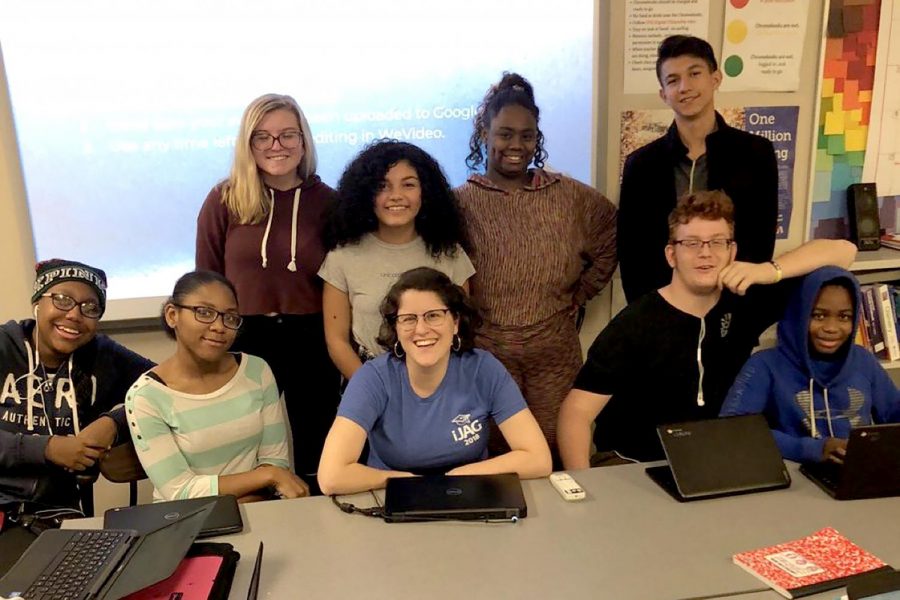What is iJAG?
January 7, 2019
Within the diverse environment of City High, there is a program that not many students know about that serves a small group of students. Although a small program, it is believed to have a great impact on the students who complete it.
“Literally every day [is crazy]. There is so little that I can anticipate, or what I can anticipate is very strange,” Lauren Darby, co-teacher of the City High iJAG program, said.”What I have learned from my students, their personalities and their running commentaries, they’re just very entertaining.”
The idea of iJAG is to teach students certain skills that they would not normally be taught in the conventional core classes. iJAG was originally devised as a response to the need for skilled workers in the workforce.
“It stands for Iowa Jobs for America’s Graduates. It is a statewide program that is part of the federal JAG program,” Darby said. “It is designed to meet the need of young people who were graduating without the necessary information for entering the workforce.”
iJAG has many differences from the way that Common Core works, such as the skills that they are taught, as well as how they learn their material. Within iJAG, the teachers focus on teaching skills that are actually going to be needed post-high school, but are still supported by the Common Core. This means that they try and continue using writing, speech, or math skills while still learning about their own curriculum.
“We do have a Common Core set of core proficiencies. They are all based on things like career development, job obtainment, job survival, basic skills, leadership and self-development, personal skills, and life survival skills,” Darby said. “We do a lot of writing tasks and public speaking tasks; we want to make sure we are reinforcing the core skills that they are working on in other classes but hopefully applying it a little bit more so they can see exactly how they are going to be using it post-high school.”
Within iJAG, the grades are split into two different groups, having ninth and tenth grades separated from eleventh and twelfth. Both of the groups focus on something different, with the ninth and tenth group focusing on more personal improvement and eleventh and twelfth focusing on post-high school skills.
“We try to divide it so that nine and ten is really about personal discovery and reflection and study skills, making goals,” Darby said. “In eleventh and twelfth really focusing on the hard skills of interviewing, writing a resume, looking for jobs, and applying for colleges…”
The curriculum for iJAG takes a broad approach to the different industries in the workforce. It emphasizes on showing all fields, including those that would take an alternative path to mastery, or ones that do not require a degree to enter. However, it does make sure the students are aware what it means to have a college degree and what sort of opportunities that would introduce.
“We do try to introduce our students to fields that have internship programs and other types of alternative paths to mastery so that they are not feeling like the only way to move forward is through a college education,” Darby said, “although we absolutely support our students in pursuing college education.”
One of the biggest differences between iJAG and the core classes is how the class is taught, following the structure of “project-based learning.” Project-based learning is a teaching style that focuses on having a major project for every unit rather than having lectures, conventional homework, quizzes, and tests. This style of learning isn’t only reserved to iJAG, but as it requires a very specific teaching environment, it is harder to find in the core classes.
“People can use project-based learning in any course, but it is time-intensive and requires flexibility and that is something that we have a lot of and so I think in some ways it’s a bit easier to use that model,” Darby said. “The real thing that differs from doing project-based learning and just doing a project is that it is supposed to have a driving question that the students are working to better understand and they can do that investigation in any way they want.”
Having a curriculum that isn’t standardized across the country, the responsibility of creating the course tends to fall on the teachers. It also allows for the students to have a larger say in and influence on what the projects are going to consist of. This grants freedom to the students, which further develops non-traditional skills.
“Well, I really like being able to make up my own curriculum. Even though we do have these core competencies that we are trying to meet, there is still a lot of freedom within that,” Darby said. “It has a lot to do with time management and developing initiative.”
The teachers not only are allowed to create the curriculum, but they are also allowed to pick and choose who is allowed into their classes. This allows the teachers to create a community of students who truly want to attend the course, as well as making the student list smaller and more attentive.
“Students have to express a desire to be here, they have to want it, they have to communicate why it’s going to help them, and they have to show up,” Darby said. “Generally, there is a pretty high retention rate from year to year. Most students will go through the whole program.”
Joining is a concern for both new students and teachers alike. For these students, there is the concern of disrupting the close community of students that had been bonding since the beginning of the trimester. There is also the concern of jumping into the middle of the curriculum. However, because of how the grades are grouped, the curriculum follows a two-year cycle, keeping things fresh while still managing to support students who don’t have prior knowledge.
“Well, they would be jumping into the curriculum instead. We try to do it on a two-year cycle so that for those students that do stick with it are getting new material each year but also for those who come in aren’t missing out on the curriculum,” Darby said. “There really isn’t that sense that you’re joining late. I think that people feel pretty included from the start.”

































Donna Henn • Jan 16, 2019 at 5:15 pm
Hats off to you and your desire to accelerate a students ability to succeed in their life choices. Creating an environment that is safe to explore “work” before the commitment of a degree or certain occupations. Innate talents should be explored and guided throughout the K-12 for our youths or children futures. The cost? A life’s passion worth living. Guidance is best offered to open minds, the school of hard knocks is NOT a plan!
Thank you for your work and creativity in iJAG
Sincerely,
Donna Henn